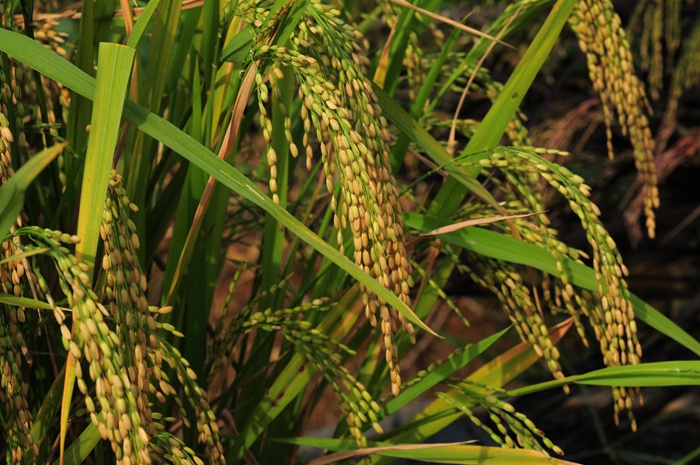- Scientific Name: Oryza sativa L.
- Ref: Sp. Pl.:333. 1753
- Synonyms:
- Oryza aristata Blanco
- O. communissima Lour.
- O. denudata (Desv.) Steud.
- O. elongata (Desv.) Steud.
- O. formosana Masam. & Suzuki
- O. glutinosa Lour.
- O. marginata (Desv.) Steud.
- O. montana Lour.
- O. mutica Steud.
- O. palustris Salisb.
- O. parviflora P.Beauv.
- O. perennis Moench
- O. plena (Prain) N.P.Chowdhury
- O. praecox Lour.
- O. pubescens (Desv.) Steud.
- O. pumila Steud.
- O. repens Buch.-Ham. ex Steud.
- O. rubribarbis (Desv.) Steud.
- O. sativa subsp. indica Shig.Kato
- O. sativa subsp. japonica Shig.Kato
- O. segetalis Russell ex Steud.
- English Common Name: rice, Asian rice
- Chinese Common Name: 稻 dào, 水稻 shuǐdào, 粳稻 gěngdào (cv. japonica), 籼稻 xiāndào (cv. indica)
- Japanese Common Name: イネ [稲/稻/禾] ine
- Family: Poaceae
- Genus: Oryza
- Distribution: Cultivated, mainly in flooded fields. Throughout most of China [domesticated in SE Asia].
- Photo: Hangzhou Botanical Garden, Zhejiang
Annual, aquatic, tufted. Culms erect, rooting at lower submerged nodes, 0.5–1.5 m tall. Leaf sheaths slightly inflated below, upper sheaths tight, glabrous, auricles falcate, ciliate; leaf blades 25–60 × 0.5–2 cm, glabrous, smooth or scabrid on both sides, margins scabrid, apex acuminate; ligule 10–40 mm. Panicle loosely contracted, up to 30 cm, nodding at maturity; branches 1–3 at lowest node, longest 2–12 cm, axils bearded or glabrous. Spikelets oblong to oblong-lanceolate, 7–10 mm, length 2–3.5 times width, persistent; sterile lemmas lanceolate, 1.5–4 mm, apex acuminate; fertile lemma papillose, spinulose, apex acuminate; awn very variable, slender or stout, up to 60 mm or more, scaberulous, sometimes absent. Anthers 1–3 mm. Caryopsis ovate or elliptic to cylindrical, 5–7 mm, whitish yellow to brown or blackish. 2n = 24. (Flora of China)
